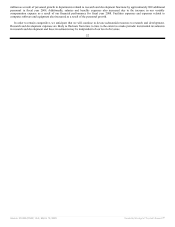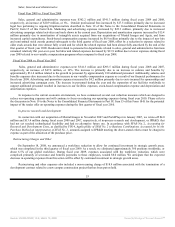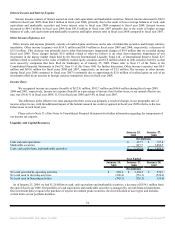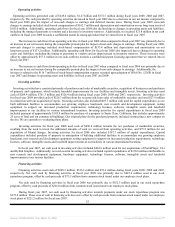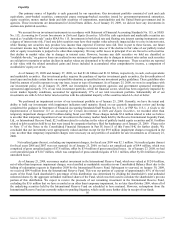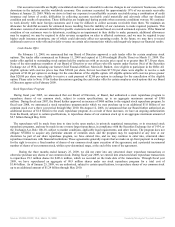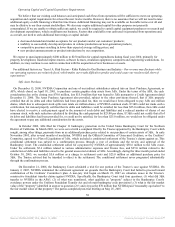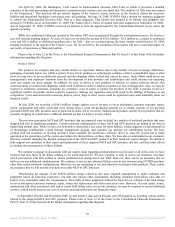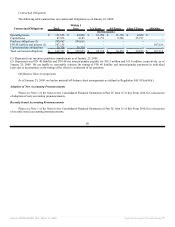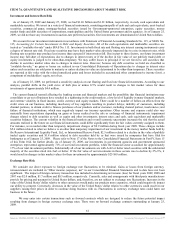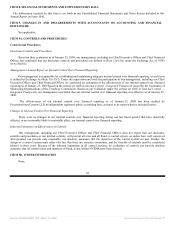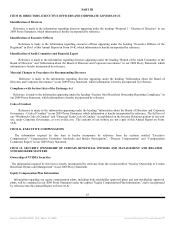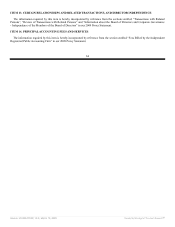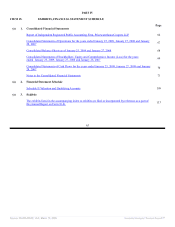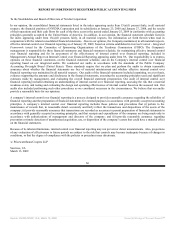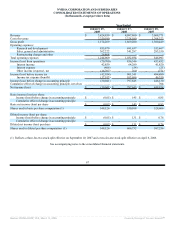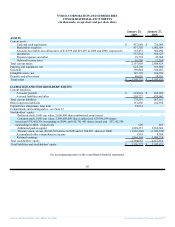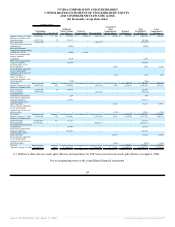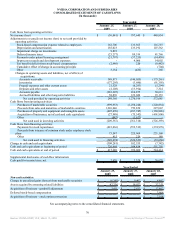NVIDIA 2009 Annual Report Download - page 75
Download and view the complete annual report
Please find page 75 of the 2009 NVIDIA annual report below. You can navigate through the pages in the report by either clicking on the pages listed below, or by using the keyword search tool below to find specific information within the annual report.
ITEM 7A. QUANTITATIVE AND QUALITATIVE DISCLOSURES ABOUT MARKET RISK
Investment and Interest Rate Risk
As of January 25, 2009 and January 27, 2008, we had $1.26 billion and $1.81 billion, respectively, in cash, cash equivalents and
marketable securities. We invest in a variety of financial instruments, consisting principally of cash and cash equivalents, asset-backed
securities, commercial paper, mortgage-backed securities issued by Government-sponsored enterprises, equity securities, money
market funds and debt securities of corporations, municipalities and the United States government and its agencies. As of January 25,
2009, we did not have any investments in auction-rate preferred securities. Our investments are denominated in United States dollars.
We account for our investment instruments in accordance with Statement of Financial Accounting Standards No. 115, or SFAS No.
115, Accounting for Certain Investments in Debt and Equity Securities. All of the cash equivalents and marketable securities are
treated as “available-for-sale” under SFAS No. 115. Investments in both fixed rate and floating rate interest earning instruments carry
a degree of interest rate risk. Fixed rate securities may have their market value adversely impacted due to a rise in interest rates, while
floating rate securities may produce less income than expected if interest rates fall. Due in part to these factors, our future investment
income may fall short of expectations due to changes in interest rates or if the decline in fair value of our publicly traded debt or
equity investments is judged to be other-than-temporary. We may suffer losses in principal if we are forced to sell securities that
decline in securities market value due to changes in interest rates. However, because any debt securities we hold are classified as
“available-for-sale,” no gains or losses are realized in our Consolidated Statements of Operations due to changes in interest rates
unless such securities are sold prior to maturity or unless declines in value are determined to be other-than-temporary. These securities
are reported at fair value with the related unrealized gains and losses included in accumulated other comprehensive income (loss), a
component of stockholders’ equity, net of tax.
As of January 25, 2009, we performed a sensitivity analysis on our floating and fixed rate financial investments. According to our
analysis, parallel shifts in the yield curve of both plus or minus 0.5% would result in changes in fair market values for these
investments of approximately $4.4 million.
The current financial turmoil affecting the banking system and financial markets and the possibility that financial institutions may
consolidate or go out of business have resulted in a tightening in the credit markets, a low level of liquidity in many financial markets,
and extreme volatility in fixed income, credit, currency and equity markets. There could be a number of follow-on effects from the
credit crisis on our business, including insolvency of key suppliers resulting in product delays; inability of customers, including
channel partners, to obtain credit to finance purchases of our products and/or customer, including channel partner, insolvencies; and
failure of financial institutions, which may negatively impact our treasury operations. Other income and expense could also vary
materially from expectations depending on gains or losses realized on the sale or exchange of financial instruments; impairment
charges related to debt securities as well as equity and other investments; interest rates; and cash, cash equivalent and marketable
securities balances. The current volatility in the financial markets and overall economic uncertainty increases the risk that the actual
amounts realized in the future on our financial instruments could differ significantly from the fair values currently assigned to them.
For instance, we recorded other than temporary impairment charges of $9.9 million during fiscal year 2009. These charges include
$5.6 million related to what we believe is an other than temporary impairment of our investment in the money market funds held by
the Reserve International Liquidity Fund, Ltd., or International Reserve Fund; $2.5 million related to a decline in the value of publicly
traded equity securities and $1.8 million related to debt securities held by us that were issued by companies that have filed for
bankruptcy as of January 25, 2009. Please refer to Note 17 of the Notes to the Consolidated Financial Statements in Part IV, Item 15
of this Form 10-K for further details. As of January 25, 2009, our investments in government agencies and government sponsored
enterprises represented approximately 71% of our total investment portfolio, while the financial sector accounted for approximately
17% of our total investment portfolio. Substantially all of our investments are with A/A2 or better rated securities with the substantial
majority of the securities rated AA-/Aa3 or better. If the fair value of our investments in these sectors was to decline by 2%-5%, it
would result in changes in fair market values for these investments by approximately $25-$63 million.
Exchange Rate Risk
We consider our direct exposure to foreign exchange rate fluctuations to be minimal. Gains or losses from foreign currency
remeasurement are included in “Other income (expense), net” in our Consolidated Financial Statements and to date have not been
significant. The impact of foreign currency transaction loss included in determining net income (loss) for fiscal years 2009, 2008 and
2007 was $2.0 million, $1.7 million and $0.5 million, respectively. Currently, sales and arrangements with third-party manufacturers
provide for pricing and payment in United States dollars, and, therefore, are not subject to exchange rate fluctuations. Increases in the
value of the United States’ dollar relative to other currencies would make our products more expensive, which could negatively impact
our ability to compete. Conversely, decreases in the value of the United States’ dollar relative to other currencies could result in our
suppliers raising their prices in order to continue doing business with us. Fluctuations in currency exchange rates could harm our
business in the future.
We may enter into certain transactions such as forward contracts which are designed to reduce the future potential impact
resulting from changes in foreign currency exchange rates. There were no forward exchange contracts outstanding at January 25,
2009.
61
Source: NVIDIA CORP, 10-K, March 13, 2009 Powered by Morningstar® Document Research℠


